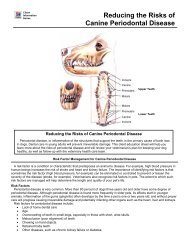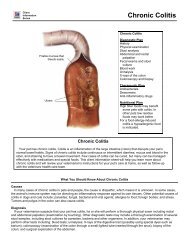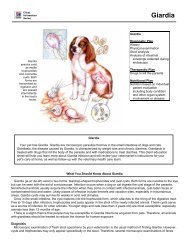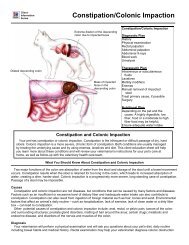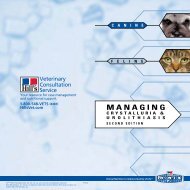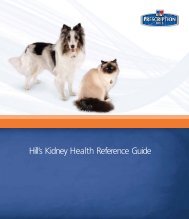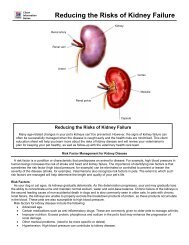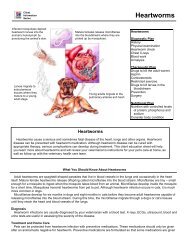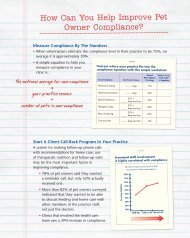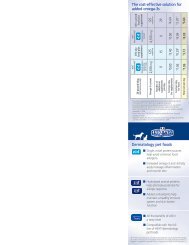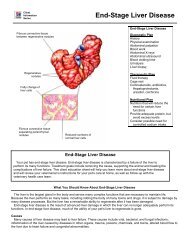Cheyletiella - HillsVet
Cheyletiella - HillsVet
Cheyletiella - HillsVet
You also want an ePaper? Increase the reach of your titles
YUMPU automatically turns print PDFs into web optimized ePapers that Google loves.
Client<br />
Information<br />
Series<br />
<strong>Cheyletiella</strong><br />
<strong>Cheyletiella</strong><br />
These mites migrate<br />
on the hair shaft on<br />
the skin’s surface<br />
and feed on tissue<br />
fluids.<br />
The entire life cycle<br />
is thought to occur<br />
on the host.<br />
Diagnostic Plan<br />
History<br />
Physical examination<br />
Skin scrapings<br />
Skin biopsy<br />
Acetate tape impressions<br />
Direct visualization of the<br />
parasite<br />
Therapeutic Plan<br />
Parasiticidal dips<br />
Nutritional Plan<br />
Nutrition based on individual<br />
patient evaluation<br />
including body condition<br />
and other organ system<br />
involvement or disease<br />
<strong>Cheyletiella</strong><br />
Your pet has <strong>Cheyletiella</strong> (walking dandruff) mites. These mites are tiny parasites that live on the skin. They<br />
cause <strong>Cheyletiella</strong> mange, a contagious skin disease. <strong>Cheyletiella</strong> infestations are treated with products that kill<br />
skin parasites. This client education sheet will help you learn more about these infestations and will review your<br />
veterinarian’s instructions for your pet’s care at home, as well as follow-up with the veterinary health care team.<br />
What You Should Know About <strong>Cheyletiella</strong><br />
<strong>Cheyletiella</strong> (sha'lĕ-te-el'lah) mange is transmitted when one pet comes in contact with another pet that already has the<br />
mite infestation. <strong>Cheyletiella</strong> mites are highly contagious, especially between animals less than 12 weeks of age.<br />
Therefore, all animals in a household may be affected. Though it is uncommon, people may become infested when they<br />
are exposed to pets with <strong>Cheyletiella</strong> mange.<br />
Signs<br />
Typically, <strong>Cheyletiella</strong> mange occurs in kittens and puppies. The most common sign of <strong>Cheyletiella</strong> mange is moderate<br />
to severe dandruff along the animal’s back. The pet may scratch a little or a lot. Intense scratching may lead to hair loss.<br />
Often, the animal’s coat may feel greasy. A few animals, especially older pets, may have <strong>Cheyletiella</strong> mites but no skin<br />
abnormalities. Yet mites from these animals may infest other pets.<br />
Diagnosis<br />
A history of recent contact with other animals followed by the onset of dandruff, scratching and hair loss suggest a<br />
diagnosis of <strong>Cheyletiella</strong> mange. A diagnosis can be confirmed by your veterinarian when he or she finds <strong>Cheyletiella</strong><br />
mites on your pet.<br />
Your veterinarian may use a magnifying lens to look for <strong>Cheyletiella</strong> mites on the surface of your pet’s skin. Other<br />
commonly used diagnostic techniques include collecting dandruff by scraping the skin, applying acetate tape to the skin or
combing dandruff scales onto a microscope slide. In these situations your veterinarian will use a microscope to look for<br />
mites in the dandruff scales. Mites and mite eggs may occasionally be found in a pet’s feces. This occurs when animals,<br />
particularly cats, ingest mites and eggs when they groom themselves. Unfortunately, mites cannot be demonstrated in all<br />
cases of <strong>Cheyletiella</strong> mange. If mites can’t be found, your veterinarian may determine the presence of the clinical signs<br />
alone warrants treating your pet for <strong>Cheyletiella</strong> mange.<br />
Treatment and Home Care<br />
<strong>Cheyletiella</strong> mites are susceptible to most insecticides, including powders, sprays, dips and shampoos. Treatment<br />
should be continued for several weeks to eliminate the infestation. Because of the highly contagious nature of the parasite,<br />
all animals in the household must be treated whether or not they have signs of infection.<br />
Cleaning the household hastens control of the infestation and helps prevent reinfestation. These measures include<br />
thorough cleaning and vacuuming. The household should be fogged or sprayed with products used for flea control.<br />
Nutritional Plan<br />
If your pet has <strong>Cheyletiella</strong> mange, your veterinarian may suggest a dietary change based on your pet’s age and body<br />
condition, the degree of infestation and tissue damage, and the presence or absence of disease in other organs and body<br />
systems. If your pet has traumatized its skin, your veterinarian may give you special feeding instructions. Nutrition is<br />
especially important for optimal growth and proper development of the immune (protective) system in puppies and kittens,<br />
such as those presented with <strong>Cheyletiella</strong> mange. Optimal nutrition should also reduce the health risks associated with<br />
feeding excess levels of nutrients such as calcium and phosphorus, which could cause skeletal problems, and excess<br />
calories, which could cause obesity. Foods formulated for optimum growth that avoid excess levels of harmful nutrients<br />
include Hill’s® Science Diet® brand puppy and kitten foods.<br />
Transitioning Food<br />
Unless recommended otherwise by your veterinarian, gradually introduce any new food over a seven-day period. Mix<br />
the new food with your pet’s former food, gradually increasing its proportion until only the new food is fed.<br />
If your pet is one of the few that doesn’t readily accept a new food, try warming the canned food to body temperature,<br />
hand feeding for the first few days, or mixing the dry food with warm water (wait ten minutes before serving). Feed only<br />
the recommended food. Be patient but firm with your pet. This is important because the success or failure of treatment<br />
depends to a large degree on strict adherence to the new food.<br />
Presented as an educational service by<br />
Client’s Name:<br />
Patient’s Name:<br />
Medication(s):<br />
Home Care Instructions<br />
_________________________________________________________<br />
_________________________________________________________<br />
_________________________________________________________<br />
Nutritional Recommendation: ___________________________________________________<br />
Follow-Up Appointment: _______________________________________________________<br />
(Hospital Stamp Area Above)<br />
REGULAR VISITS WILL HELP OUR VETERINARY HEALTH CARE TEAM PROVIDE FOR YOUR PET’S BEST INTEREST.<br />
©2011 Hill’s Pet Nutrition, Inc.<br />
®/ Trademarks owned by Hill’s Pet Nutrition, Inc.



